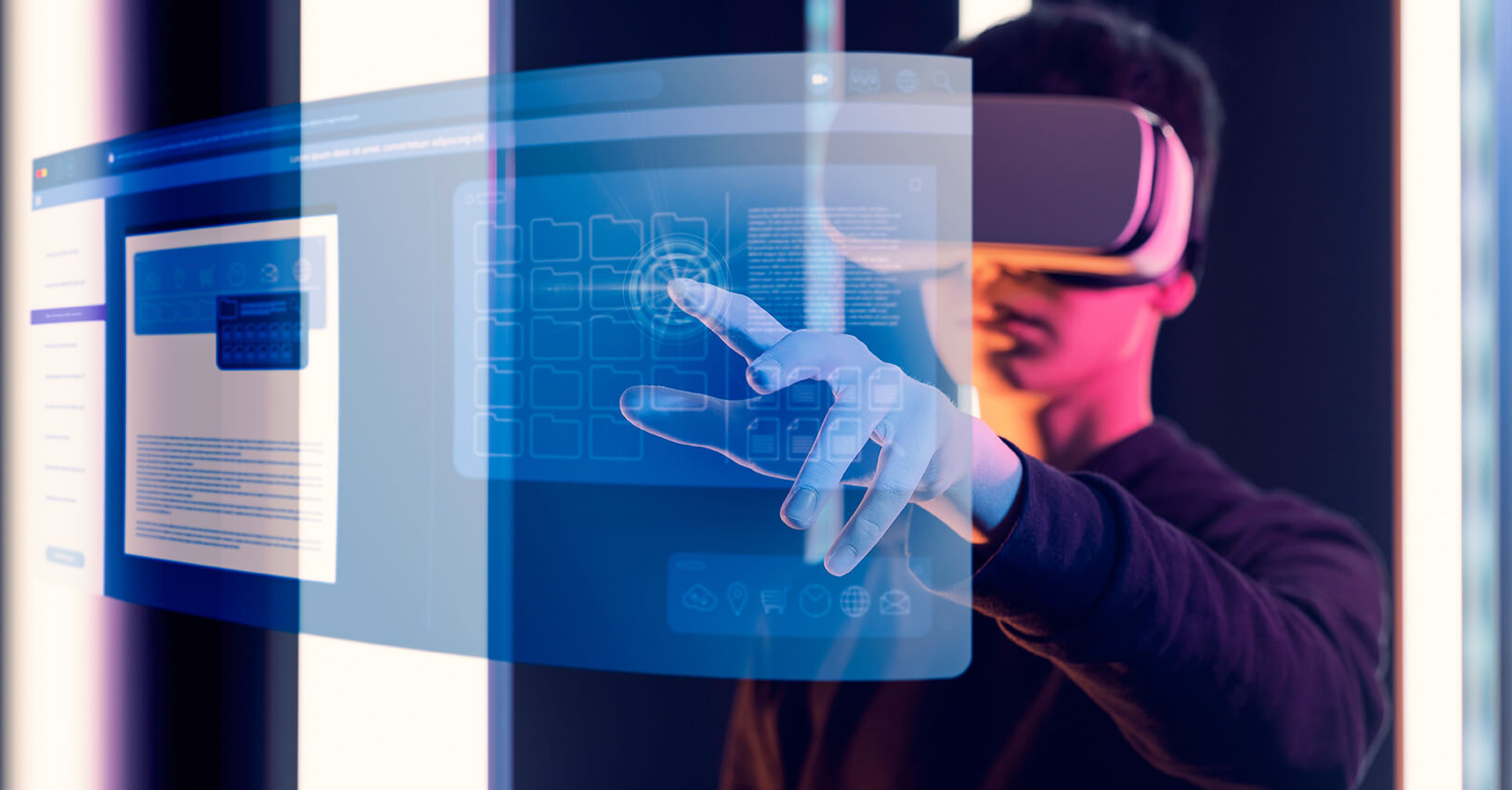


Home »
Reading Time: 7 minutes
In the world of technology, something really exciting is happening. It’s called spatial computing, and it’s re-envisioning how we interact with digital devices and products. The evolutionary technology is all about making digital experience immersive, syncing it with our natural surroundings. Imagine you can interact with digital elements just like you do with physical things around you. Conversations around spatial computing have peaked interest off late due to the launch of Apple’s Vision Pro, a mixed reality headset powered by spatial computing.
Spatial computing is a technology that enables computers to blend in with the physical world in a natural way. It allows users to interact with digital content as if it is physically present in their space, using the most intuitive inputs possible — their eyes, hands, and voice. Spatial computing has been gaining more attention and popularity in recent years, thanks to the advancements in hardware and software.
It utilizes a range of technologies, including AI, ML, AR, and IoT, to establish an awareness of the three-dimensional (3D) environment surrounding an object, enabling it to interact seamlessly with its surroundings. Advances in computational capabilities have been instrumental in enabling this capability. Spatial computing finds extensive utility across personal and vocational domains. For instance, it can enable medical students to practice surgery, users to play games that blend the digital and physical worlds, and doctors to project medical images onto the patient’s body. Spatial computing opens up a new realm of possibilities for how we interact with and perceive the world around us.
One of the most anticipated developments in the spatial computing domain is the emergence of groundbreaking devices that are shaping the future of user interface (UI) and user experience (UX). This new era has been ignited by recent advancements, bringing about a transformative shift in how we interact with technology.
Several tech giants are investing heavily in the development of spatial computing devices, such as Apple’s Vision Pro, Microsoft’s HoloLens, and Meta’s Oculus. These devices aim to provide users with seamless and intuitive interactions with spatial content, such as apps, entertainment, photos, videos, and communication. Each of these companies has its own vision and strategy for spatial computing, as well as its own strengths and weaknesses in the market. For example, Apple has a large and loyal customer base, Microsoft has a strong foothold in the enterprise sector, and Meta has a dominant position in the social media domain.
The launch of these devices and the presence of other credible competitors pose a significant challenge for UI/UX designers. How will they adapt to the new paradigm of spatial computing? What are the best practices and guidelines for designing spatial interfaces? How will they balance user comfort, safety, and satisfaction in immersive environments? These are some of the questions that UI/UX designers will have to grapple with as they enter a new era of spatial computing.
Spatial computing introduces a new dimension to UI/UX design. Unlike traditional 2D interfaces that are confined to the boundaries of a screen, spatial interfaces can fill the space around the user, creating an infinite canvas for apps. This means that designers have to think beyond pixels and layouts, and consider spatial elements such as depth, scale, perspective, lighting, shadows, occlusion, and motion.
Some of the key principles and guidelines for designing spatial interfaces are:
Spatial UI/UX design envisions a landscape where our eyes, hands, and voice take center stage as primary interaction tools. Imagine effortlessly gazing at an element to select it, seamlessly tapping your fingers together to trigger actions, and fluidly typing using virtual keyboards or voice dictation. Gone are the days of conventional gestures – spatial UI/UX design introduces touchless controls, ushering in a realm of advanced interactions that transcend the limitations of current methods.
In spatial user interfaces (UI), a pivotal aspect is furnishing users with prompt cues and affordances. These cues shed light on potential actions and their ensuing outcomes within the spatial realm. Feedback and cues can span visual, auditory, and haptic dimensions, either singly or in tandem. For instance, spatial UI might employ visual highlights, resonating sounds, or subtle vibrations to spotlight interactive elements. It could also deploy animations, auditory cues, or tactile vibrations to unveil the results of user-initiated actions. By orchestrating these feedback elements deftly, users adeptly navigate the spatial environment, fostering an intuitive and fluid interactive experience.
Spatial UI/UX design embodies a profound respect for the user’s boundaries and comfort, unlike the traditional landscape where interfaces occasionally neglect the user’s personal space. For instance, a video player that starts playing sound when the user hovers over it disregards the user’s personal space. Moreover, spatial UI/UX design is synonymous with adaptability. Rather than existing as static entities, interfaces evolve with the context and environment they inhabit. Imagine UI elements that dynamically adjust their size, position, orientation and even appearance to harmonize with varying contexts. Whether it’s scaling elements proportionate to their proximity to the user’s eyes or morphing colors and transparencies to complement diverse backgrounds and lighting conditions – spatial UI/UX design caters to the fluidity of the user’s surroundings, ensuring a seamless, harmonious interaction at every turn.
As the sun sets on the conventional UX design, VR and AR cast a radiant glow on the horizon. This new era beckons, not as a futuristic concept, but as an imminent reality where digital experiences seamlessly merge with our lives. These cutting-edge technologies are rewriting the rules, promising an era of interaction that transcends screens and boundaries.
But embarking on this journey requires a willingness to embrace the uncharted. To unlock the potential of VR and AR, designers and developers must be trailblazers, experimenting and evolving to stay ahead in this rapidly changing landscape.
As we embark on this uncharted voyage, it’s crucial to recognize that our means of navigation are still a work in progress. The landscape of virtual reality (VR), augmented reality (AR), and spatial computing remain in a constant state of flux, resembling a puzzle that is continually being rearranged. In navigating this ever-evolving terrain successfully, cultivating an appetite for experimentation becomes paramount—a readiness to tread unexplored paths, a willingness to grapple with ambiguity, and embrace the unforeseen. It’s not merely about crafting aesthetically pleasing interfaces anymore; it’s about donning the mantle of a pioneer, orchestrating fresh trajectories for human-technology interactions.
Partner with Innover to transcend into the world of surrealism envisioned and crafted by our state-of-the-art UI/UX studio. Prepare for, and conquer the future of intuitive and immersive driven by seasoned experts. From augmented reality (AR) and virtual reality (VR) to mixed reality (MR), our expertise lies in seamlessly merging the physical and digital worlds to create captivating and user-centric interfaces. Get ready for a future where reality and imagination converge seamlessly to redefine the way users engage with technology through cutting-edge spatial computing solutions.